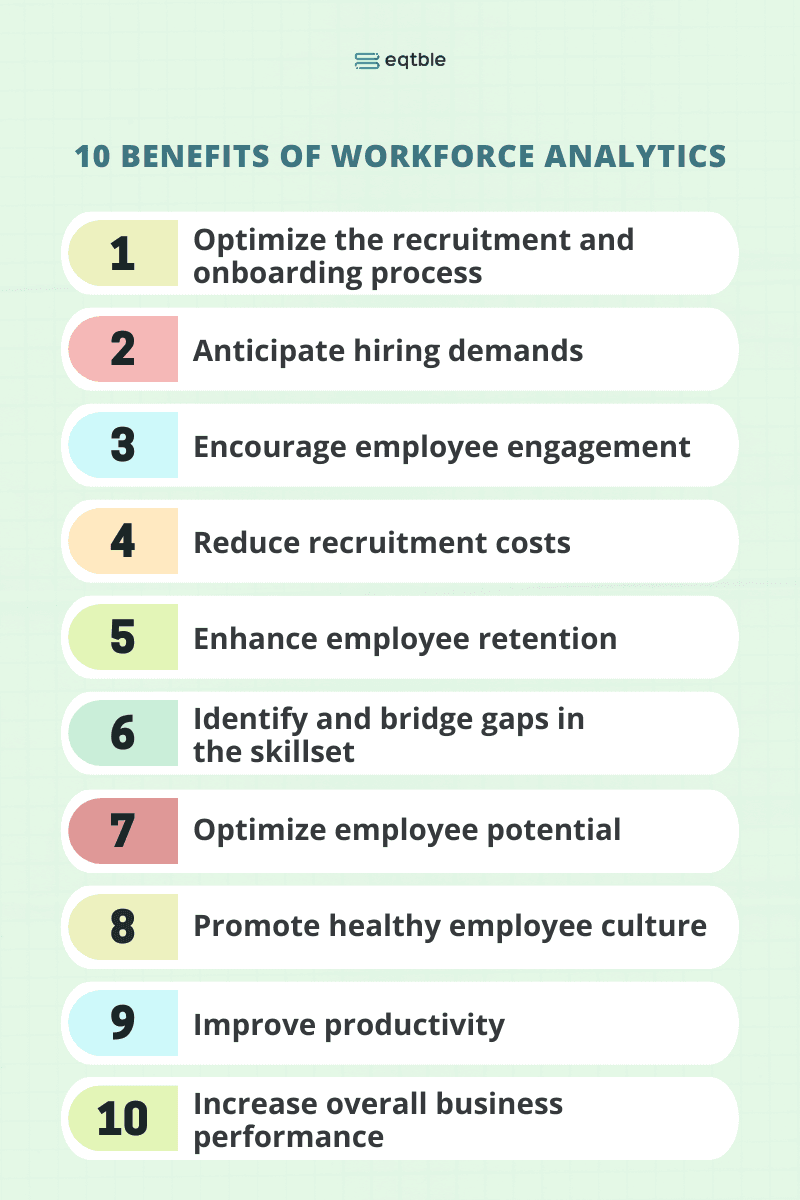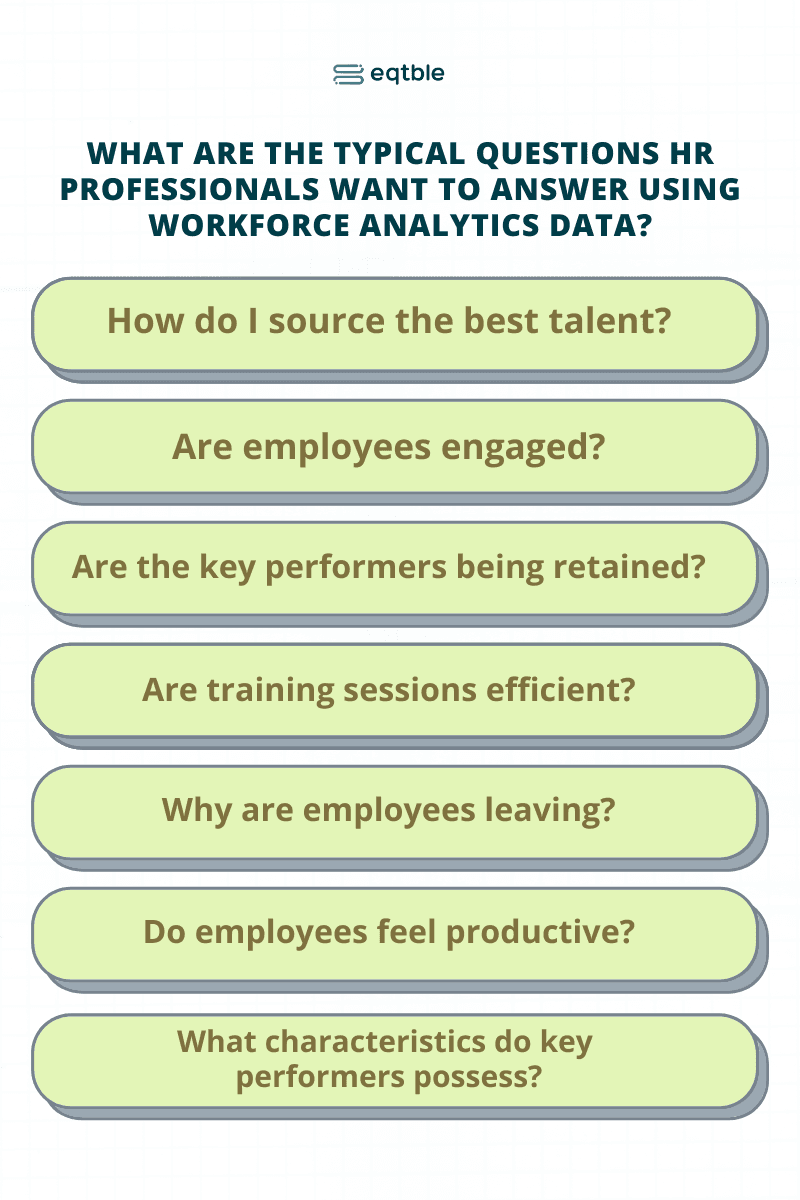HR Analytics
July 18, 2022
The Ultimate Guide to Understanding Workforce Analytics
Understanding workforce analytics may seem like a daunting task, but it’s nothing to be afraid of. Workforce analytics helps to provide valuable information which aids recruitment, productivity, and management.
This article aims to answer questions about what it entails, its relevance, and ways you can implement it.

What is Workforce Analytics?
Workforce analytics refers to the measurement and analysis of employee data to improve planning and management in the workplace.
Evaluating and understanding this data was initially limited to HR departments, but workforce analysis has evolved and has an overall impact on business performance.
It is valuable across different managerial levels, departments, and teams and provides critical insights to improve recruitment, retention, performance, collaboration, and engagement.
Differentiating between Workforce Analytics, HR Analytics, and People Analytics
The terms workforce analytics, HR analytics, and people analytics are often used interchangeably and can be confusing to differentiate. But, the difference is in the metrics they measure.
Workforce analytics focuses on the workplace in its entirety, such as measuring and analyzing employee data, processes, and systems that influence and impact performance and overall management.
HR analytics is an umbrella term referring to any analysis done by the HR department which seeks to improve HR processes. HR analytics boosts the efficacy of HR operations by collating data such as the length of the recruitment process, workforce analytics, and people analytics.
People analytics extends beyond the workplace and focuses on individuals. It explores metrics like individual job satisfaction, work-life balance, and general well-being.
These terms are often used interchangeably, with their definitions blurring into each other. It is less about semantics and more about analyzing the data and utilizing it to make informed decisions to improve productivity and the organization.

Importance of Workforce Analytics
Tracking employee data with workforce analytics helps to improve workforce planning by predicting employee action and prescribing and developing a strategy to guide teams, HR departments, and managers.
Workforce analytics monitor trends for talent management by tracking the following:
Recruitment
Monitoring the efficiency of the hiring process helps to track the ability to source and recruit talent. It provides insights on hiring needs and the availability of skills in demand for current and future recruitment.
Retention
By evaluating the retention rate, organizations can track employee satisfaction with management strategies. Poor retention rates can be due to dissatisfaction with compensation, lack of engagement, and training opportunities. By monitoring this trend, organizations can develop strategies to retain employees by addressing possible causes.
Employee Management
Workforce analytics tracks the productivity and engagement of employees as this boosts retention and overall performance. Employees who are engaged are more likely to be productive and feel fulfilled with their jobs.
Performance appraisals and surveys help to gauge the efficiency of employees and their future potential.
Absent days
Tracking recurrent absenteeism of employees provides insight into productivity and the value of the organization to them. Monitoring and addressing frequent absent days can improve the health of employee culture.
Training
Professional and organizational development can bridge gaps in the onboarding process by tracking key performance indicators (KPIs). Regular training improves the skill set of employees and makes them more efficient at their jobs, thereby increasing productivity.
Benefits of Workforce Analytics
Workforce analytics is instrumental to workplace planning because of benefits such as the following:
Anticipate hiring demands
Optimize the recruitment and onboarding process
Encourage employee engagement
Reduce recruitment costs
Enhance employee retention
Identify and bridge gaps in the skillset
Optimize employee potential
Promote healthy employee culture
Improve productivity
Increase overall business performance
Ways to implement Workforce Analytics

When considering workforce analytics, a framework is needed. If you are convinced of the importance of workforce analytics and would love to get started, you should:
Define the problem
What question are you trying to answer? Determine the scope of the problem and the desired outcome.
For example- Why is employee retention low?
Determine what information would be needed to solve the problem
The problem to be addressed determines the data to be collected. Does the necessary information already exist, or does it need to be updated? Set out to derive the data.
The needed information for the example above would be in the results from employee surveys. Are employees feeling unproductive or underpaid?
Set the baseline data
The baseline data refers to existing data of the metric to be measured. It serves as a comparison to the data collected in the future.
Decide how to interpret and report the data.
Interpret the data considering the problem being solved and use a workforce analytics report to compare existing data with current data.
For example, has employee retention increased since employees felt engaged and became more productive?
How is Workforce Analytics evolving?
Workforce analytics leverages data to reveal the link between employee performance and business profitability. In recent times, organizations have utilized workforce analytics to monitor and analyze employee data. This data influences strategic thinking and implementation.
Trends and Tools in Workforce Analytics
Metrics such as employee retention and productivity can be tracked and used to predict and prioritize hiring demands.
Innovative technology such as computerized tools and predictive workforce analytics guarantee accurate results.
1. Computerized workforce analytics tools
Using software solutions to automate data collection and mining helps to spot trends in data sets accurately.
2. Predictive and prescriptive workforce analytics
Proven algorithms predict future demands with data mining and machine learning. Workforce data is interpreted and optimized with prescriptive statistical tools which examine potential opportunities and risks based on existing challenges and data.
Better Way to Visualize your Workforce Analytics
Workforce analytics is essential to the growth of your organization. Workforce planning can be made easy with simple and direct visualization. Use AI-powered data intelligence to track employee data with Eqtble and say goodbye to spreadsheets.
Eqtble provides seamless integration with all your HR tools, so you can track trends to improve engagement, talent retention, and compensation with a data-driven approach and no technical knowledge required.
FAQS on Workforce Analytics
Who can utilize Workforce Analytics in an organization (other than HR)?
The insights gained from workforce analytics have evolved beyond the HR department because workforce analytics can track collaboration and productivity across departments and teams. The data from workforce analytics is beneficial to managers, team leads, and employees with different levels of accessibility to data.
Why is Workforce data analytics so important?
Workforce analytics examine trends in employee data, which can help predict and prescribe solutions to potential demands in the hiring process, onboarding process, and retention of talent, among other benefits.
What are the typical questions HR professionals want to answer using Workforce Analytics data?
How do I source the best talent?
Are employees engaged?
Are the key performers being retained?
Are training sessions efficient?
Why are employees leaving?
Do employees feel productive?
What characteristics do key performers possess?
What is the difference between workforce analytics and people analytics?
Workforce analytics focuses on the connection between employee data and overall productivity and business profitability. People analytics focuses on individual employee data.
Workforce analytics enhances employee engagement and productivity. Show your employees that you are listening to them, and you want them to thrive by having a data-driven approach.
Eqtble helps you unlock the value of your data. If you are interested in getting early access to our tool, please click here to begin your seamless people analytics journey!







